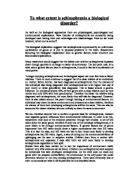With the aid of specific examples, describe the concept of a hierarchy of biological organization. What is meant by the phrase the whole is greater than the sum of its parts?
BIO156 Karin Estell September 15, 2012
Question: With the aid of specific examples, describe the concept of a hierarchy of biological organization. What is meant by the phrase “the whole is greater than the sum of its parts?”
Answer: In an attempt to appreciate the world from a biological view of molecules, cells, and atoms; the study in which these properties build upon each other, called emergent properties, aid in understanding the human body and other life forms and the functions that nonliving matter contribute that assist to support life. Using the concept of biology to study life, we are able to place life into specific hierarchical levels of biological organization. Understanding how each level in this hierarchy and the outside elements work together to perform the many functions of sustaining and supporting life can sum up the phrase, “the whole is greater than the sum of its parts” be understood.
The hierarchy of biological organization is a group of different systems that sustain life through emergent properties. The first four levels of this organized group are the biosphere, ecosystem, community, and population. The biosphere contains all the living and nonliving matter here on earth. The nonliving matters, such as sunlight, wind, and bodies of water and land have a direct effect on the living matter contained in the biosphere. The second level is the ecosystem which at various locations, contain all living organisms and nonliving matter in one place. Within the ecosystem are many organisms sharing the elements is called a community. For instance, a forest community would contain animals, plants, and insects all of which are affected by the nonliving matter that surrounds them. The last of the first four systems is called a population. A population is a group of one type of organism, group, or individuals who interact with each other. The first four levels of the hierarchy of biological organization along with nonliving matter work together to encompass the entire planet and support life.








